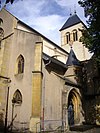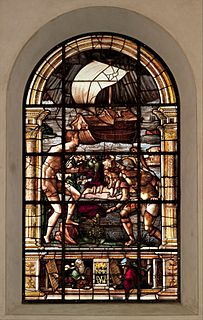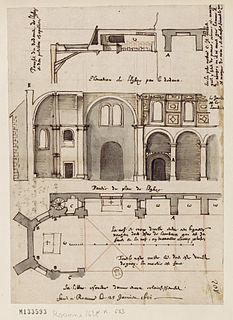List of the Historic Monuments in Metz
Religious Monuments
| Monument | Image | Current Use | Address | Period | Year of Classification | Notes | Reference |
|---|---|---|---|---|---|---|---|
| Saint-Arnulf Abbey of Metz |  | Circle Officer | Aux-Ours and Poncelet Streets | 16th century | 1986 | Ancient imperial necropolis of the family of Emperor Charlemagne. Displays a polychromatic Pietà from the 16th century. | [2] |
| Saint-Clement Abbey of Metz |  | Lorraine Region Parliament | Pontiffroy Street | 17th century | 1972 | [3] | |
| Sainte-Glossinde Abbey of Metz |  | Episcopal Palace | Sainte-Glossinde Square | 18th century | 1978 | [4] | |
| Saint-Pierre-aux-Nonnains Basilica of Metz |  | Exhibition venue (see: Metz Arsenal) | Esplanade Garden | 4th century | 1909 | Once a Roman spa, it is the oldest church in France and one of the oldest in Europe and in the world. | [5] |
| Saint-Stephen Cathedral |  | Cathedral | John Paul II Square | 13th century | 1930 | Largest expanse of stained glass windows in the world and tenth highest nave in the world. Displays stained glass windows of Hermann von Münster, Laurent-Charles Maréchal, Valentin Bousch, Marc Chagall, Roger Bissière, and Jacques Villon | [6] |
| Mercy Chapel |  | Chapel | Street of the Chèvre | 12th century | 1968 | [7] | |
| Templars' Chapel |  | Exhibition venue (see: Metz Arsenal) | Esplanade Garden | 12th century | 1840 | Once part of the Templar commandery of Metz, the oldest Templar institution of the Holy Roman Empire. | [8] |
| Petit-Saint-Jean Chapel | Ruins | Vincentrue Street | 13th century | 1973 | [9] | ||
| Saint-Genest Chapel |  | Chapel | En-Jurue | 12th century | 1929 | Edifice adjacent to the house where François Rabelais lived in Metz | [10] |
| East Cemetery |  | Cemetery | Strasbourg Avenue | 19th century | 2003 | Catholic necropolis | [11] |
| Saint-Clement Church |  | Lorraine Parliament | Gabriel-Hocquard Square | 16th century | 1992 | [12] | |
| Saint-Sauveur Collegiate | Ruins | Petit-Paris Street | 15th century | 1929 | [13] | ||
| Recollets Convent of Metz |  | Municipal Archives | Recollets and Abbé-Risse Streets | 14th century | 1972 | [14] | |
| Carmelites Convent of Metz | Jazz Concert Venue | Trinitarians' Impasse | 13th century | 1930 | [15] | ||
| Grands-Carmes Church |  | Ruins | Marchant Street | 14th century | 1929 | [16] | |
| Trinitarian Church of Metz |  | Museums of Metz | Trinitarians' Street | 18th century | 1973 | [17] | |
| Notre-Dame Church of Metz |  | Church | Goat's Street | 17th century | 1968 | Displays a rare complete set of 21 stained glass windows of Laurent-Charles Maréchal. | [18] |
| Sainte-Lucie Church of Metz |  | Church | Jean-Pierre-Jean Street | 11th century | 1991 | [19] | |
| Sainte-Ségolène Church of Metz |  | Church | Joan of Arc Square | 13th century | 1981 | [20] | |
| Sainte-Thérèse-de-l'Enfant-Jésus Church of Metz | Church | Verdun Street | 20th century | 1998 | Built by architect Roger-Henri Expert, displays stained glass windows by Nicolas Untersteller. | [21] | |
| Saint-Étienne-le-Dépenné Church of Metz |  | Private Edifice | Gaudrée Street | 14th century | 1928 | [22] | |
| Saint-Eucaire Church of Metz |  | Church | Germans' Street | 12th century | 1979 | [23] | |
| Saint-Martin Church of Metz |  | Church | Lasalle Street | 12th century | 1925 | [24] | |
| Saint-Maximin Church of Metz |  | Church | Mazelle Street | 12th century | 1923 | Displays stained glass windows of Jean Cocteau. | [25] |
| Saint-Simon-Saint-Jude Church of Metz | | Church | France's Square | 18th century | 1989 | Near the launching site of the first airmail carrier. | [26] |
| Saint-Vincent Abbey of Metz |  | Basilica, High School, and Tourist Attraction | Saint-Vincent Square | 10th century | 1930 | [27] | |
| Protestant New Temple |  | Church | Comedy's Square | 20th century | 1930 | Temple Neuf | [28] |
| Synagogue of Metz |  | Synagogue | Rabbin-Elie-Bloch Street | 19th century | 1984 | Displays interesting sculpted Torah ark and designed Parochet. | [29] |
Military Monuments
| Monument | Image | Current Use | Address | Period | Year of Classification | Notes | Reference |
|---|---|---|---|---|---|---|---|
| Cloister's Barracks |  | High School | 17th century | 1926 | [30] | ||
| Ney Barracks |  | Barracks | Republic's Square | 19th century | 1929 | [31] | |
| Royal Military School |  | Military School | Winston-Churchill Street | 18th century | 1929 | [32] | |
| Medieval Defensive Walls |  | Parks and Gardens | Along the Moselle and the Seille Rivers | 13th century | 1929 | [33] | |
| Germans' Gate |  | Ornament | Maginot Boulevard | 13th century | 1929 | Medieval defensive gate | [33] |
| Camoufle Tower |  | Ornament | Foch Avenue | 15th century | 1929 | Medieval watchtower | [33] |
| Queuleu Fort |  | Memorial and Park | Jean Burger Alley | 19th century | 1970 | Use as detention and torture center by the Waffen-SS during World War II. | [34] |
| Bellecroix Fort |  | Ornament and Parks | Corps-Expéditionnaire-Français's Street | 18th century | 1982 | Fortification of Louis de Cormontaigne. | [35] |
| Citadel Store Food |  | Hotel | Ney Avenue | 17th century | 1969 | Remains of the fortifications of Vauban. | [36] |
| Military Hospital of the Moselle Fort |  | Administration | Paul-Wiltzer Embankment | 18th century | 1937 | [37] | |
| Moselle fort |  | Housing | 18th century | 1929 | [38] | ||
| Chambière Barrack Gates | Ornament | 18th century | 1929 | [39] | |||
Civil Monuments
| Monument | Image | Current Use | Address | Period | Year of Classification | Notes | Reference |
|---|---|---|---|---|---|---|---|
| Antonist Granary |  | Medical Center | Piques Street | 14th century | 1930 | [40] | |
| Coislin Fountain |  | Ornament | Coislin Street | 18th century | 1929 | [41] | |
| Chèvremont Granary |  | Museums of Metz | Chèvremont Street | 13th century | 1924 | [42] | |
| Saint-Nicolas Fountain | Ornament | Saint-Nicolas Square | 18th century | 1929 | [43] | ||
| Gargan Private House |  | House | En-Nexirue | 15th century | 1929 | ||
| Bulette Private House |  | House | Sainte-Croix Square | 14th century | 1931 | [44] | |
| Sainte-Croix Fountain |  | House | Walls' and Hell Streets | 18th century | 1929 | [45] | |
| Malta Private House |  | Ornament | Sainte-Croix Square | 13th century | 1989 | [46] | |
| Town Square |  | Public Place | Place d'Armes | 18th century | 1948 | Built on the place of the ancient Palace of the Republic of Metz. Work of the Royal architect Jacques-François Blondel in order built in Metz a modern square in a context of the Enlightenment. | [47] |
| Burtaigne Private House |  | Housing | Charrons' Square | 16th century | 2006 | [48] | |
| Saint-Livier Private House | Exhibition venue and museum | Trinitarians' Street | 12th century | 1939 | The oldest civilian edifice of the city, today the Contemporary Art Deposit of the Lorraine Region. | [49] | |
| Heu Private House |  | Housing | Fountain's Street | 15th century | 1990 | [50] | |
| Opera-Theater and surrounding edifices | | Opera House | Comedy's Square | 18th century | 1930 | Oldest opera house working in France. | [51] [52] |
| Saint-Louis Square and its Buildings |  | Housing, markets, and public place | Saint-Louis Square | 13th century | 1929 | Built on the ancient defensive walls of Roman Divodurum. | [53] [54] [55] [56] [57] [58] [59] [60] [61] [62] [63] [64] [65] [66] [67] [68] [69] [70] [71] [72] [73] [74] [75] [76] [77] [78] |
| Gournay Private House |  | Housing | Grand-Deer Street | 18th century | 1929 | Birthplace of General Antoine Charles Louis de Lasalle. | [79] |
| Heads' House |  | Restaurant | En-Fournirue | 16th century | 1929 | [80] | |
| Verlaine's House |  | Museum | Haute-Pierre Street | 19th century | 1978 | Birthplace of Poet Paul Verlaine. | [81] |
| Chamber's Square |  | Housing, Markets, Restaurants, and Hotel | Chamber Square | 16th and 18th centuries | 1923 | [82] | |
| Saint-Stephen Square |  | Public place | Saint-Stephen Square | 18th century | 1975 | Once used as an amphitheatre for Mystery plays during the Middle Ages | [83] |
| Thermae Bridge |  | Bridge | 4th century 14th century | 1927 | Displays remains of a Gallo-Roman bridge. | [84] | |
| Gallo-Roman Ruins |  | Museums of Metz | Haut-Poirier Street | 4th century | 1938 | Remains of the public baths of ancient Gallo-Roman Divodurum. | [85] |
| Various houses and edifices |  | Housing | Metz Streets | from 13th to 19th century | from 1928 to 1986 | [86] [87] [88] [89] [90] [91] [92] [93] [94] [95] [96] [97] [98] [99] [100] [101] [102] [103] [104] [105] [106] [107] [108] [109] [110] | |
Administrative Monuments
| Monument | Image | Current Use | Address | Period | Year of Classification | Notes | Reference |
|---|---|---|---|---|---|---|---|
| Metz Railway Station |  | Railway Station | General De Gaulle Square | 20th century | 1975 | Built during German annexation. Station-Palace as it displays the apartments of the Kaiser. | [111] |
| Saint-Nicolas Hospice |  | Administration | Saint-Nicolas Square | 16th century | 1993 | Oldest Hospital of Metz. | [43] |
| City Hall |  | City Hall | Town Square | 18th century | 1922 | Work of Royal architect Jacques-François Blondel. | [112] |
| Guardroom |  | Tourism Office | Town Square | 18th century | 1921 | Work of Royal architect Jacques-François Blondel. | [113] |
| Parliament of Metz |  | Markets | Town Square | 18th century | 1928 | Work of Royal architect Jacques-François Blondel. | [114] |
| Guildhall |  | Bank and Restaurant | Mondon Square | 20th century | 2002 | Built during German annexation. | [115] |
| Central Post Office |  | Post Office | Gambetta Street | 20th century | 1975 | Built during German annexation. | [116] |
| Royal Governor Palace | Courthouse | Haute-Pierre Street | 18th century | 1921 | Place where Lafayette decided to participate to the American Revolutionary War. | [117] | |
| Imperial Governor Palace | Military Headquarters | Citadel Street | 20th century | 1975 | Serves as residence of the Kaiser during his visits in Metz. | [118] | |











